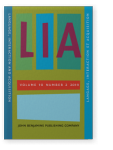Vol. 10:2 (2019) ► pp.229–254
Le développement de l’expression du genre grammatical en français L2
Les cas de chose, famille, maison, nourriture et vie
Les recherches portant sur l’acquisition de l’expression du genre grammatical en français langue seconde (L2) nous montrent, entre autres, que les apprenants réussissent plus souvent à marquer le genre avec un nom masculin (vs. un nom féminin) et sur les déterminants plutôt que sur les adjectifs. En revanche, il n’est pas clair si ces tendances générales s’appliquent de la même manière à l’ensemble des noms, adjectifs et déterminants concernés. En d’autres termes, nous pouvons nous demander à quel point l’expression du genre grammatical est déterminée par des spécificités lexicales. Est analysée, dans cette étude, l’évolution du marquage en genre produit par un groupe de 20 apprenants britanniques du français L2 sur une période de 21 mois. Des productions orales et écrites recueillies à trois périodes différentes ont été analysées, et le marquage en genre avec cinq noms féminins fréquents – chose, famille, maison, nourriture, vie – a fait l’objet d’une étude approfondie. Les résultats montrent que l’expression du genre grammatical se développe différemment avec ces cinq noms, résultat qui est interprété à l’aide des approches basées sur l’usage.
Article outline
- 1.Introduction
- 2.Le cadre théorique et les recherches précédentes
- 2.1Les approches basées sur l’usage
- 2.2Le genre grammatical en français
- 2.3L’expression du genre grammatical en français L2
- 3.La présente étude
- 3.1Le corpus LANGSNAP
- 3.2Les participants
- 3.3L’analyse des données
- 3.4L’analyse : résultats et discussion
- 3.4.1L’expression du genre : Taux de réussite
- 3.4.2Une caractérisation des cinq noms dans un corpus de référence
- 3.4.3 Une caractérisation des usage events
- 3.4.4Bilan
- 4.Conclusion
- Remarques
-
Références
Article language: French
